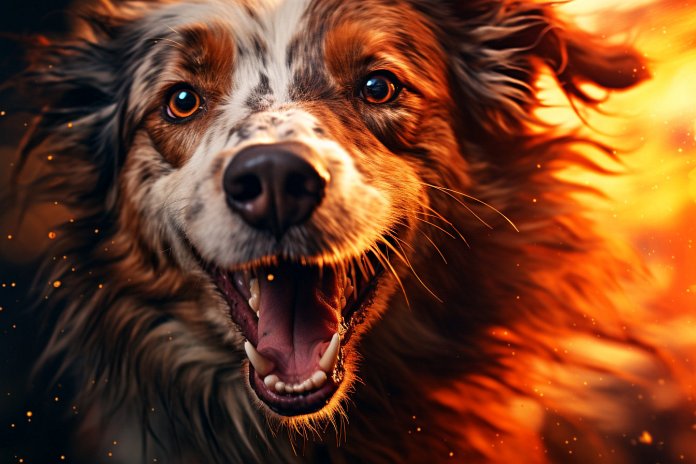
An aggressive dog can be terrifying to encounter, regardless of its size. Dogs have been domesticated for thousands of years, but they can still display aggressive behavior. There are various reasons why dogs become aggressive. Let’s explore some of these reasons.
Signs of Aggressive Behavior
Aggressive behavior in dogs is not limited to certain breeds. Small dogs can be just as aggressive as larger ones. Human interaction and treatment of dogs can greatly influence their temperament. Dogs that are mistreated or have not been properly socialized can display fear aggression. Dogs that are afraid may cower, growl, and bark, while dominant dogs may exhibit confident body language and guard their territory. Some dogs may be aggressive towards certain family members or possessive of their food or toys. Others may display aggression while chasing or barking at people or animals.
Body Language Signs
Aggressive behavior in dogs can be identified through various signs, including barking, guarding, raised hair on the back, snapping, tail tucking, and ears pushed back. Other signs may include biting, growling, showing bared teeth, attacking family members, and chasing people or other animals.
History of Aggressive Breeds
Certain dog breeds, such as Pit Bulls, have gained a reputation for being aggressive. However, it is important to note that these breeds have been bred for specific purposes, such as bear and bull baiting or illegal dogfighting. The behavior of these breeds can be attributed to human influence and breeding practices.
The Science of Aggression in Dogs
Dogs are descendants of wolves, which display aggressive behavior to protect their pack. Humans have selectively bred dogs to perform specific tasks, which has influenced their behavior and physical traits. Some researchers believe that aggression can be bred out of dogs over time, as seen in the breeding of foxes. Studies have also identified specific genes linked to aggression in dogs.
Tips for Dealing with Aggressive Behavior
If a normally friendly dog suddenly becomes aggressive, it may be experiencing pain or imitating its owner’s harsh treatment. Seeking veterinary advice is recommended. Using punishment methods to curb aggression is ineffective and can lead to further problems. Implementing safety measures, such as using a muzzle in public or installing a baby gate at home, can help manage aggressive behavior. Seeking the help of a professional dog trainer is also recommended.
Safety Tips for Aggressive Dogs
To ensure the safety of both the dog and others, it is important to muzzle aggressive dogs in public and seek guidance from a dog trainer. Installing a baby gate at home can provide a safe environment for visitors. Consulting with a veterinarian and sharing experiences with other dog owners can also be beneficial. Additionally, reading informative articles about training aggressive dogs can provide valuable insights.
“Understanding the signs and causes of aggression in dogs is the first step towards creating a safer and happier environment for both pets and owners.”

Tips & Things to Know
1️⃣ Understand the reasons behind aggression in dogs: Dogs can become aggressive due to various factors such as fear, mistreatment, lack of socialization, or possessiveness. It is important to understand the root cause of aggression in order to address it effectively.
2️⃣ Recognize the signs of aggression: Aggressive behavior in dogs can manifest through barking, growling, snapping, biting, and displaying dominant body language. By being able to identify these signs, you can take appropriate measures to manage and prevent aggression.
3️⃣ Seek professional help and use positive training methods: If your dog is displaying aggressive behavior, it is crucial to consult with a dog trainer or veterinarian who specializes in aggression. Punishment-based methods should be avoided as they can exacerbate aggression. Instead, focus on positive reinforcement and reward-based training techniques to modify your dog’s behavior.
Frequently Asked Questions, Answered ✅
1. Why do dogs become aggressive?
– Dogs can become aggressive for various reasons, including fear, mistreatment, lack of socialization, and genetic factors.
2. How can I tell if a dog is feeling aggressive?
– Signs of aggression in dogs include barking, guarding, raised hackles, snapping, tail tucking, and ears pinned back.
3. Are certain dog breeds more prone to aggression?
– While certain dog breeds may have a reputation for aggression, it is important to note that aggression is not solely determined by breed. Factors such as training, socialization, and individual temperament play a significant role.
4. Can aggression in dogs be bred out over time?
– Some research suggests that aggression in dogs may have a genetic component and could potentially be bred out over time with careful breeding practices.
5. What should I do if my dog displays aggressive behavior?
– If your dog suddenly becomes aggressive, it is important to consult with a veterinarian to rule out any underlying medical issues. Working with a professional dog trainer or behaviorist can also help address and modify aggressive behavior.